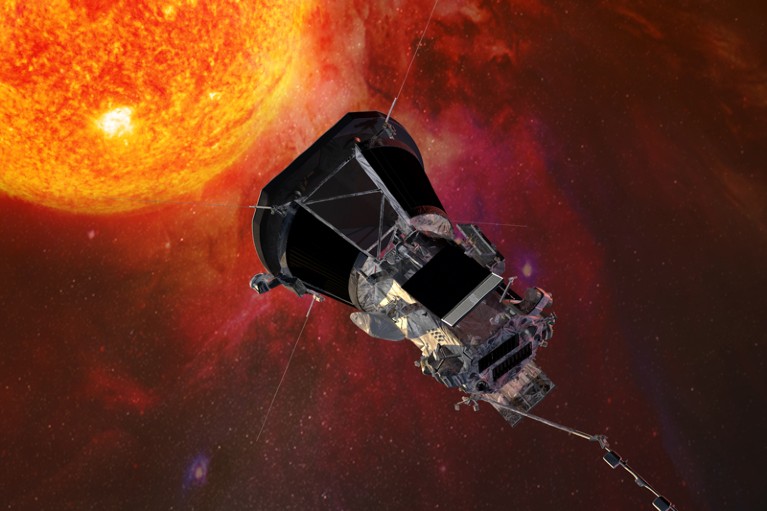
A place in the Sun: the Parker Solar Probe will make 21 flybys of the Sun in the next 6 years.Credit: Johns Hopkins APL
In some ways, NASA’s Parker Solar Probe can trace its ancestry to the tale of Icarus, the character from ancient Greek mythology who famously took flight by donning wings made from feathers and wax. Ignoring advice from his wise father, Daedalus, Icarus flew too close to the Sun, causing the wax to melt, and plummeted to his death.
In the spirit of the Icarus legend, the Parker Solar Probe is one of the most daring space missions ever launched, but there’s no metaphorical melting wax. The probe’s cutting-edge scientific instruments live behind a carbon-composite heat shield 11 centimetres thick that can withstand temperatures of almost 1,400 °C.
The mission’s achievements are thanks in no small measure to the work of teams at the Johns Hopkins University Applied Physics Laboratory in Laurel, Maryland, who built the $1.5-billion probe and designed its trajectory.
The probe was originally supposed to start its journey by flying past Jupiter — the idea being that Jupiter’s gravitational influence would hurl it out of the plane of the planets and over the Sun’s poles, from where it would record its measurements. But Yanping Guo, a celestial navigator at the Maryland lab, found a way to send it past Venus instead. This, she reasoned, would keep the probe on a path in the planetary plane and would mean the spacecraft could visit the Sun more often and spend more time close to the star. Since its 2018 launch, the probe has passed close to the Sun 3 times — and it will do so another 21 times in the next 6 years, sending back exclusive data from the SolarSystem’s hottest and most dangerous object.
This week, a News & Views article discusses four papers, published in Nature, that report the first of the probe’s discoveries, resolving mysteries such as the birthplace of the energetic particles that make up the solar wind, which floods interplanetary space.
Astrophysicist Eugene Parker at the University of Chicago in Illinois proposed the existence of the solar wind more than 60 years ago (E. N. Parker Phys. Fluids 1, 171–187; 1958). At that time, few of his peers accepted that he was on to something. Now, at the age of 92, Parker can justifiably revel in the data from the spacecraft named after him.
The Parker Solar Probe has many more solar flybys ahead of it, taking it progressively closer to the star. The spacecraft has yet to cross a long-anticipated boundary into the Sun’s corona, or outer atmosphere; beyond that lies a ‘here be dragons’ realm that no one has ever seen.
The ghost of Icarus has finally been laid to rest. Much more science is sure to come.

 Sun-bombing spacecraft uncovers secrets of the solar wind
Sun-bombing spacecraft uncovers secrets of the solar wind
 A step closer to the Sun’s secrets
A step closer to the Sun’s secrets
 Read the paper: Highly structured slow solar wind emerging from an equatorial coronal hole
Read the paper: Highly structured slow solar wind emerging from an equatorial coronal hole
 Read the paper: Alfvénic velocity spikes and rotational flows in the near-Sun solar wind
Read the paper: Alfvénic velocity spikes and rotational flows in the near-Sun solar wind
 Read the paper: Probing the energetic particle environment near the Sun
Read the paper: Probing the energetic particle environment near the Sun
 Read the paper: Near-Sun observations of an F-corona decrease and K-corona fine structure
Read the paper: Near-Sun observations of an F-corona decrease and K-corona fine structure
 Death-defying NASA mission will make humanity’s closest approach to the Sun
Death-defying NASA mission will make humanity’s closest approach to the Sun







